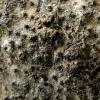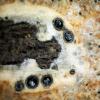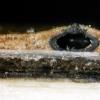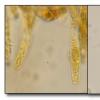
20-12-2025 23:08
Patrice TANCHAUDBonsoir, récolte sur sol sablonneux dans l'arri�

21-12-2025 09:32
Hello.A tiny ascomycete found embedded in wood in

20-12-2025 15:47
Mirek GrycHi.These grew on pine wood that was heavily covere

18-12-2025 21:17
Pol DebaenstThe identification took me to Byssonectria deformi

15-12-2025 07:09
 Danny Newman
Danny Newman
indet. Rutstroemiaceae sp. on unk. fallen leavesMc

19-12-2025 10:10
Patrice TANCHAUDBonjour, récolte réalisée en milieu dunaire, a

18-12-2025 17:23
 Bruno Coué
Bruno Coué
Bonjour,je serais heureux d'avoir votre avis sur c
Diatrypaceae
Gernot Friebes,
14-04-2009 16:25
who can help me with this pyrenomycet? I am not even sure which genus it belongs to. Found most likely on Fraxinus, the spores are 7,8-8,5 x 2-3 µm, the asci are long stipitate and IKI-.
Best wishes,
Gernot
Jacques Fournier,
14-04-2009 16:44

Re:Diatrypaceae
Hi Gernot,
just like you I am not sure of the genus. I hesitate between Cryptosphaeria and Eutypa. Species in both genera occurring on Fraxinus do not have such spores. Cryptosphaeria is characterized by a conspicuous black line at the surface of the wood just beneath the bark. You can see it on a tangential section of the bark, like on the attached photo. If the black line is not present it should be an Eutypa.
The morphology of ostioles and iodine reaction would help.
Jacques
just like you I am not sure of the genus. I hesitate between Cryptosphaeria and Eutypa. Species in both genera occurring on Fraxinus do not have such spores. Cryptosphaeria is characterized by a conspicuous black line at the surface of the wood just beneath the bark. You can see it on a tangential section of the bark, like on the attached photo. If the black line is not present it should be an Eutypa.
The morphology of ostioles and iodine reaction would help.
Jacques
Gernot Friebes,
14-04-2009 18:04
Re:Diatrypaceae
Hello Jacques,
thank you for your answer! I am not sure what you mean with the black line at the surface of the wood – is it the darker line surrounding the blackish wood in the left part of the photo?
The asci are IKI- as I mentioned in my first posting, the ostioles are crowded, black, a little bit prominent and the wood underneath the ostioles seems to be somehow swollen. The perithecia are very crowded in a tangential section.
Best wishes,
Gernot
thank you for your answer! I am not sure what you mean with the black line at the surface of the wood – is it the darker line surrounding the blackish wood in the left part of the photo?
The asci are IKI- as I mentioned in my first posting, the ostioles are crowded, black, a little bit prominent and the wood underneath the ostioles seems to be somehow swollen. The perithecia are very crowded in a tangential section.
Best wishes,
Gernot
Jacques Fournier,
14-04-2009 18:24

Re:Diatrypaceae
sorry, it was not clear, the black line appears on cross section beneath the bark, and as a black surface in tangential section, as on the photo.
Your fungus should be an Eutypa. The apical rings do not react directly in Melzer's reagent, they need a pretreatment in 3% KOH for a few seconds. It can work directly with Lugol's solution but they are usually very small and remain inconspicuous in this medium because the ascal cytoplasm does not retract as strongly as in the other method.
The ostioles must be measured, the diameter is more informative than the height, and it must be assessed whether they are smooth, furrowed or cruciform. Sorry, Diatrypaceae are not that easy!
Perithecial diameter should be recorded too, as the colour of the surrounding tissues.
More soon!
Jacques
Your fungus should be an Eutypa. The apical rings do not react directly in Melzer's reagent, they need a pretreatment in 3% KOH for a few seconds. It can work directly with Lugol's solution but they are usually very small and remain inconspicuous in this medium because the ascal cytoplasm does not retract as strongly as in the other method.
The ostioles must be measured, the diameter is more informative than the height, and it must be assessed whether they are smooth, furrowed or cruciform. Sorry, Diatrypaceae are not that easy!
Perithecial diameter should be recorded too, as the colour of the surrounding tissues.
More soon!
Jacques
Alain GARDIENNET,
14-04-2009 18:48
Re:Diatrypaceae
Fraxinus is not likely, is it ?
Wait for the informations asked by Jacques...
Alain
Wait for the informations asked by Jacques...
Alain
Jacques Fournier,
14-04-2009 19:04

Re:Diatrypaceae
merci Alain, je ne suis pas certain non plus qu'il s'agit de Fraxinus. La structure de l'écorce rappelle un peu Quercus non?
Gernot, you should sort this out with a photo of a cross section of the wood, does it have rays or not?
I retrieved a photo of Cryptosphaeria eunomia showing the black line.
Jacques
Gernot, you should sort this out with a photo of a cross section of the wood, does it have rays or not?
I retrieved a photo of Cryptosphaeria eunomia showing the black line.
Jacques
NC NC,
14-04-2009 20:05
Re:Diatrypaceae
Hello,
@Jaques: The asci do not react neither in Melzer's reagent pretreated with KOH nor in Lugol but in Melzer's reagent the asci have a really long apex. The ostioles are 0,26 up to 0,43 mm in diameter and have no defined surface, they are just somehow uneven-rough. The perithecia are 0,42 up to 0,76 mm in diameter and surrounded by a blackish tissue. Now with your second picture of the black line in the wood I think I can see it within my collection, tomorrow I will take a picture of it.
@Alain: I am not sure whether it is Fraxinus. There was Poppulus, Carpinus, Quercus, Sambucus and Prunus around. If knowing the host is indispensable I will try to identify it microscopically but I do not have alcohol and glycerin at home so it would take some time.
Best wishes,
Gernot
picture: left asci in Lugol, right ascus in Melzer's reagent pretreated with KOH:
@Jaques: The asci do not react neither in Melzer's reagent pretreated with KOH nor in Lugol but in Melzer's reagent the asci have a really long apex. The ostioles are 0,26 up to 0,43 mm in diameter and have no defined surface, they are just somehow uneven-rough. The perithecia are 0,42 up to 0,76 mm in diameter and surrounded by a blackish tissue. Now with your second picture of the black line in the wood I think I can see it within my collection, tomorrow I will take a picture of it.
@Alain: I am not sure whether it is Fraxinus. There was Poppulus, Carpinus, Quercus, Sambucus and Prunus around. If knowing the host is indispensable I will try to identify it microscopically but I do not have alcohol and glycerin at home so it would take some time.
Best wishes,
Gernot
picture: left asci in Lugol, right ascus in Melzer's reagent pretreated with KOH:
Gernot Friebes,
14-04-2009 20:17
Re:Diatrypaceae
Hello,
@Jaques: The asci neither react in Lugol nor in Melzer's reagent pretreated with KOH, but in Melzer's reagent the asci have a very long apex (dead state). The ostioles are 0,26 up to 0,43 mm in diameter and do not have a defined surface, just somehow uneven-rough. The perithecia are 0,42 up to 0,76 mm in diameter and surrounded by a blackish tissue. Now with your second picture of the black line in the wood I think I can see it within my collection. Tomorrow I will take a photo of it.
@Alain: I am not sure whether the host is Fraxinus, there was also Poppulus, Carpinus, Quercus, Sambucus and Prunus around there. If the host is indispensable I could try to identify it microscopically but I do not have alcohol or glycerin at home so it would take some time.
Best wishes,
Gernot
picture: left asci in lugol, right ascus in Melzer's reagent pretreated with KOH
@Jaques: The asci neither react in Lugol nor in Melzer's reagent pretreated with KOH, but in Melzer's reagent the asci have a very long apex (dead state). The ostioles are 0,26 up to 0,43 mm in diameter and do not have a defined surface, just somehow uneven-rough. The perithecia are 0,42 up to 0,76 mm in diameter and surrounded by a blackish tissue. Now with your second picture of the black line in the wood I think I can see it within my collection. Tomorrow I will take a photo of it.
@Alain: I am not sure whether the host is Fraxinus, there was also Poppulus, Carpinus, Quercus, Sambucus and Prunus around there. If the host is indispensable I could try to identify it microscopically but I do not have alcohol or glycerin at home so it would take some time.
Best wishes,
Gernot
picture: left asci in lugol, right ascus in Melzer's reagent pretreated with KOH
Jacques Fournier,
14-04-2009 20:33

Re:Diatrypaceae
the non furrowed ostioles is a distinctive character, usually that of E. lata which is very common, and very tricky!
But the lack of reaction with iodine and fat ascospores do not fit this taxon. I am afraid it is going to be difficult, again!
Jacques
But the lack of reaction with iodine and fat ascospores do not fit this taxon. I am afraid it is going to be difficult, again!
Jacques
Gernot Friebes,
14-04-2009 21:38
Re:Diatrypaceae
I tested the asci again in Lugol but still there is no reaction. Diatrypaceae really are not easy...
Best wishes,
Gernot
Best wishes,
Gernot
Gernot Friebes,
15-04-2009 20:19
Gernot Friebes,
15-04-2009 20:21
Jacques Fournier,
15-04-2009 20:59

Re:Diatrypaceae
Hi Gernot,
I think you are right about the black line and it is a Cryptosphaeria.
Such orbicular stromata raising the periderm are typical of C. lignyota (Fr.:Fr.) Auersw. After Rappaz (1987) the tissue beneath the perithecia is grey brown, the ostioles most often smooth to poorly ridged and the apical ring I+ but very small. He gives the spores size range 7-11.5 x 2-2.5 µm, which is quite in agreement with your measurements.
C. lignyota occurs on bark of Populus. Judging from your photo the wood sems fairly homogenous, which fits Populus better than Fraxinus. If you can confirm the identity of the wood by comparison with wood of Populus, I think we got it.
Jacques
I think you are right about the black line and it is a Cryptosphaeria.
Such orbicular stromata raising the periderm are typical of C. lignyota (Fr.:Fr.) Auersw. After Rappaz (1987) the tissue beneath the perithecia is grey brown, the ostioles most often smooth to poorly ridged and the apical ring I+ but very small. He gives the spores size range 7-11.5 x 2-2.5 µm, which is quite in agreement with your measurements.
C. lignyota occurs on bark of Populus. Judging from your photo the wood sems fairly homogenous, which fits Populus better than Fraxinus. If you can confirm the identity of the wood by comparison with wood of Populus, I think we got it.
Jacques
Alain GARDIENNET,
15-04-2009 21:05
Re:Diatrypaceae
It was my idea since the first time, I saw the first line on the first photo of Gernot. I did not propose it, I should have done it.
Good job !
Good job !
Gernot Friebes,
15-04-2009 21:53
Re:Diatrypaceae
Hello Jaques and Alain,
if both of you think of C. lignyota than it almost has to be right ;).
With a key by Hassler and Hirschmann for the microscopical identification of wood I come to the group of "Zerstreutporige Laubhölzer" (I do not know how to translate that properly...maybe "hardwood with scattered pores" ) and there to the group of trees with single to paired pores. Within this group there are only Populus and Prunus which were also in the habitat where I found this Cryptosphaeria. Prunus, however, has a totally different arrangement of the pores so Populus is the only tree that remains. I remember that near to the location of my finding was a big Populus but of course also other trees.
I think my finding has a name now thanks to you!
Best wishes and thanks again for your patience,
Gernot
if both of you think of C. lignyota than it almost has to be right ;).
With a key by Hassler and Hirschmann for the microscopical identification of wood I come to the group of "Zerstreutporige Laubhölzer" (I do not know how to translate that properly...maybe "hardwood with scattered pores" ) and there to the group of trees with single to paired pores. Within this group there are only Populus and Prunus which were also in the habitat where I found this Cryptosphaeria. Prunus, however, has a totally different arrangement of the pores so Populus is the only tree that remains. I remember that near to the location of my finding was a big Populus but of course also other trees.
I think my finding has a name now thanks to you!
Best wishes and thanks again for your patience,
Gernot









